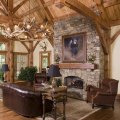Timber frame houses have a unique charm that blends time-honored craftsmanship with modern flexibility. What once began as a staple of rustic architecture—defined by exposed beams, pitched roofs, and traditional joinery—has evolved into a building style that can adapt to various aesthetics, from cozy cottages to sleek, minimalist homes. The appeal of timber framing lies in its structural integrity and visual warmth. Massive wooden beams create open, airy interiors with fewer load-bearing walls, allowing homeowners to shape their spaces freely. Whether you're drawn to the traditional appeal of stained oak or the clean lines of modern interiors, timber frame construction offers the framework—literally and figuratively—for endless creativity.
Design Freedom Inside and Out
One of the most impressive features of timber frame homes is the way they invite both design cohesion and contrast. Inside, expansive rooms benefit from high ceilings and natural light that filters through large windows framed by rich wood. This openness makes it easy to integrate modern kitchens, industrial lighting, or bold design accents. On the exterior, timber frames can be paired with a variety of cladding materials like stone, metal, glass, or fiber cement to create a specific architectural feel. That means you can build a mountain lodge in the woods, a glass-walled retreat in the city, or a coastal-inspired getaway, all using the same underlying structure. Even finishes like landscaping, decks, or the work of house painters play a key role in customizing and completing the look, bringing personality and cohesion to every edge of the home.
Durability That Matches Its Beauty
Beyond aesthetics, timber frame houses are known for their durability and environmental appeal. The strength of the wooden beams, when properly maintained, can last centuries—many historic timber buildings still stand today. These homes are energy-efficient as well, especially when combined with modern insulation and glazing methods. Wood’s natural insulating properties help regulate indoor temperatures, making these homes comfortable year-round. And because timber is a renewable resource, builders and eco-conscious homeowners alike appreciate its sustainable profile. With the right planning and sourcing, timber frame construction can strike a perfect balance between beauty, strength, and responsibility.
Embracing Rustic Roots Without Being Stuck in the Past
Timber frame homes are not limited to old-fashioned aesthetics, and that’s where their versatility really shines. Some owners choose to highlight the rustic elements, keeping the beams exposed and using earth-toned color palettes to evoke a cabin-like feel. Others go the opposite direction—whitewashing the wood, adding sleek modern furniture, or integrating smart home technology. The framing becomes a feature, not a limitation. Architects and designers are increasingly pushing the boundaries by combining traditional materials with contemporary layouts, giving rise to a new generation of timber homes that feel cutting-edge while remaining rooted in tradition.
A Lasting Foundation for Future Living
Ultimately, timber frame houses offer a rare combination of emotional warmth, architectural flexibility, and long-term resilience. They’re homes that age gracefully and mold themselves to the evolving tastes of their inhabitants. Whether your dream is a rustic retreat surrounded by forest or a modern home with dramatic open spaces, timber framing provides the bones for something truly special. With the right finishes, creative vision, and attention to detail, a timber frame home can be anything but ordinary—ready to be lived in, loved, and passed down through generations.



